中西方服装文化差异(英文)
中美服装差异英文作文
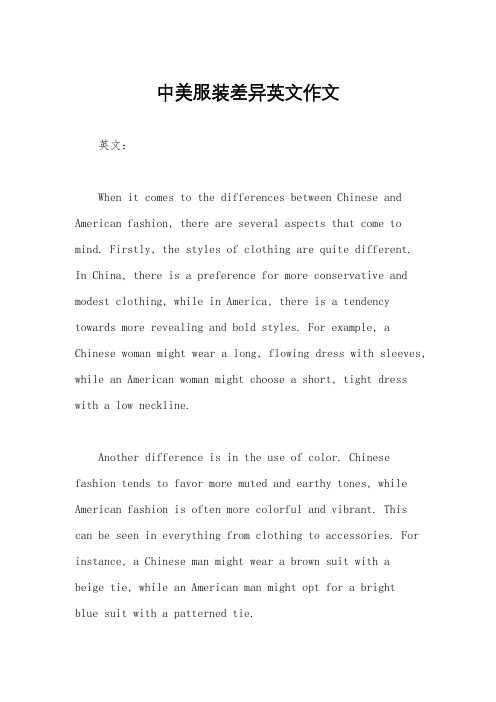
中美服装差异英文作文英文:When it comes to the differences between Chinese and American fashion, there are several aspects that come to mind. Firstly, the styles of clothing are quite different.In China, there is a preference for more conservative and modest clothing, while in America, there is a tendency towards more revealing and bold styles. For example, a Chinese woman might wear a long, flowing dress with sleeves, while an American woman might choose a short, tight dress with a low neckline.Another difference is in the use of color. Chinese fashion tends to favor more muted and earthy tones, while American fashion is often more colorful and vibrant. This can be seen in everything from clothing to accessories. For instance, a Chinese man might wear a brown suit with abeige tie, while an American man might opt for a brightblue suit with a patterned tie.Finally, there is a difference in the way that clothing is worn. In China, there is a tradition of layering clothing, with several layers worn on top of each other. In America, clothing is often worn in a more simple and straightforward manner. For example, a Chinese woman might wear a blouse, sweater, and coat all at once, while an American woman might simply wear a t-shirt and jacket.中文:谈到中美服装的差异,有几个方面需要考虑。
中西文化差异(英文ppt)
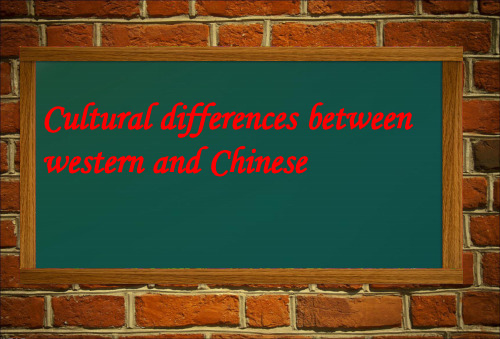
Differences in education
The gap of teaching system between China and America is big.
• Chinese students always complain about their homework.Too much homework has limited the time to exercise and relax.They try their best to get a high mark.Homework comes the first to them.
• In west countries, people like eating hamburgers, chips, pizza, pasta as their main course, they eat them with vegetable salad, they eat with drinking (water or juice),and they eat with separate plates.
• Western education is more interesting .Teachers pay attentions to training students skills in thinking in realistic life not to emphasis on the importances of memories.
Living style
• Chinese prefer getting up early and sleep early too. We usually go home early and cook meals.
中西方文化差异(英文版)

4. Thanks and Responses
In China,“Thank you” is not frequently used between intimate friends and family members because it may imply a certain distance between the addresser and the addressee.
East&West
when we talk to the westerns, we must avoid asking some questions like this:
“How old are you?” “Are you married?” “How many children do
you have?” “How much do you
• 1.“I am afraid I must be off, I have to …” • 2.“Well, it’s been nice to see you again. I do enjoy our
talk and the lovely dinner, but I must be going soon”. • 3.“Thank you very much for asking me over. I hope
Western and Chinese cultures have
diverse ways to deal with leave-takings.
• Western people always try to make their leaving sound reluctant by finding some reasons and apologize for it to make the leaving acceptable for both parties. They often signal several times before leaving. Such a people do not live with their children or relatives.
中西方服饰文化差异英文
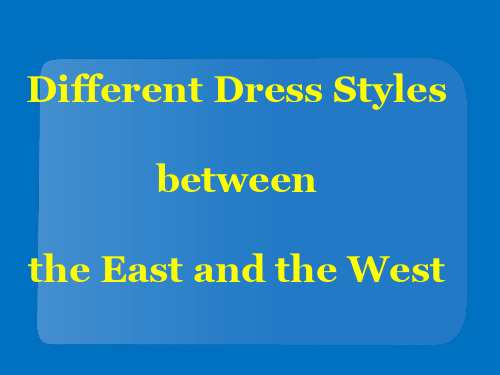
1. Advocate the beauty of human body
Clothing in the west often acts as a part of human art
2. Attract the attention of the opposite sex
3. Emphasize the expression of character
Self-design(自我设计) Self-expression(自我表现) Self-invention(自我创造)
4. Pursue the excitement of sense organ
Meticulous design(精心设计) Particular color matching(独特的色彩搭配) Special line segmentation(特殊的线条分割)
5.Influenced by Chinese traditional culture
•peaceful reunification(和平统一)—— Confucius(孔子) •Gentle(文质彬彬)——confucianist(儒家)
The Western Dress
• Advocate the beauty of human body • Attract the attention of the opposite sex • Emphasize the expression of character • Pursue the excitement of sense organ
3. Value the effect of style and steady
4. Value the nationality of costume cu Chinese traditional culture
中西方服装文化差异英文优秀课件
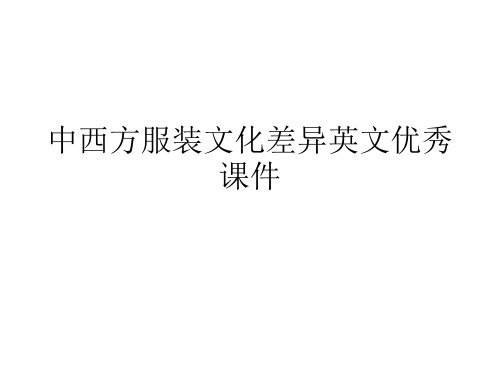
Compared with the Chinese clothes, the western clothes are more colorful.
Wide, easygoing, elegant is the basic elements of traditional Chinese costume.
In Chinese clothing culture, there some traditional and important color like red.
中西方服装文化差异英文优秀 课件
Dress culture is a cultural phenomenon unique to human beings. As it has different aesthetic ideas, different dressing concepts and different dress etiquette in China and west, it forms Chinese and western dress culture of the different connotation and characters.
China: conservative VS the West: opening
Major Traditional Chinese clothes
Chinese Cheongsam旗袍
The cheongsam is a female dress with distinctive Chinese features and enjoys a growing popularity in the international world of high fashion.
中西文化差异比较(英文)
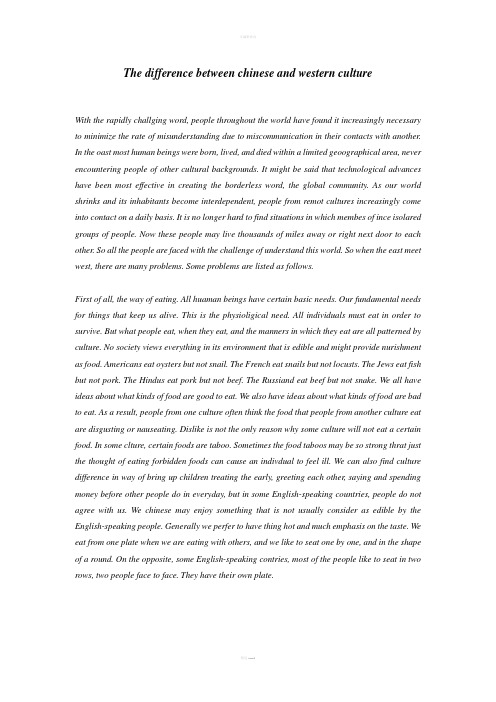
The difference between chinese and western cultureWith the rapidly challging word, people throughout the world have found it increasingly necessary to minimize the rate of misunderstanding due to miscommunication in their contacts with another. In the oast most human beings were born, lived, and died within a limited geoographical area, never encountering people of other cultural backgrounds. It might be said that technological advances have been most effective in creating the borderless word, the global community. As our world shrinks and its inhabitants become interdependent, people from remot cultures increasingly come into contact on a daily basis. It is no longer hard to find situations in which membes of ince isolared groups of people. Now these people may live thousands of miles away or right next door to each other. So all the people are faced with the challenge of understand this world. So when the east meet west, there are many problems. Some problems are listed as follows.First of all, the way of eating. All huaman beings have certain basic needs. Our fundamental needs for things that keep us alive. This is the physioligical need. All individuals must eat in order to survive. But what people eat, when they eat, and the manners in which they eat are all patterned by culture. No society views everything in its environment that is edible and might provide nurishment as food. Americans eat oysters but not snail. The French eat snails but not locusts. The Jews eat fish but not pork. The Hindus eat pork but not beef. The Russiand eat beef but not snake. We all have ideas about what kinds of food are good to eat. We also have ideas about what kinds of food are bad to eat. As a result, people from one culture often think the food that people from another culture eat are disgusting or nauseating. Dislike is not the only reason why some culture will not eat a certain food. In some clture, certain foods are taboo. Sometimes the food taboos may be so strong thrat just the thought of eating forbidden foods can cause an indivdual to feel ill. We can also find culture difference in way of bring up children treating the early, greeting each other, saying and spending money before other people do in everyday, but in some English-speaking countries, people do not agree with us. We chinese may enjoy something that is not usually consider as edible by the English-speaking people. Generally we perfer to have thing hot and much emphasis on the taste. We eat from one plate when we are eating with others, and we like to seat one by one, and in the shape of a round. On the opposite, some English-speaking contries, most of the people like to seat in two rows, two people face to face. They have their own plate.On the aspect of table manners, there are many differences between chinese and English-speaking people. For example, in some Englishi-speaking countries, Bread plates are to the left of the main plate, beverage glasses are to the right. Salad fork, knife and soup spoon are further from the main plate than the main course knife, fork and spoon. When eating bread rolls, break off a piece before buttering. Use the knife only to butter the bread, not to cut it. They should not start eating before your host does or instructs to do so. At larger meals, it is considered okay to start eating once others have been served. When finished, place the knife and fork together at five o’clock with the fork on the left. It is considered rude to answer the telephone at the table. If need to take an urgent call, excuse self and go outside. Try to eat all the food you are served. But in China, the table manners are different. Chinese traditionally eat rice from a small bowl held in the left hand. The rice bowl is raised to the mouth and the rice pushed into the mouth using the chopsticks. Some Chinese find it offensive to scoop rice from the bowl using a spoon. If rice is served on a plate, as is more common in the West, it is acceptable and more practical to eat it with a fork or spoon. The thumb must always be above the edge of the bowl. The host should always make sure the guests drinks are sufficiently full. One should not pour for ones self, but should offer to pour for a neighbor. When your drink is being poured, you should say "thank you" and tap fingers on the table to show appreciation. When people wish to clink drinks together in the form of a cheer, it is important to observe that younger members should clink the edge of their drink below the edge of an elder to show respect.Secondly, the way of communication. Form birth to death, communication plays an integral part in our life. There are some language problems, including the different styles of using language such as direct, indirect; expansive, succinct; argumentative, conciliatory; instrumental, harmonnizing; and so on. These different styles can lead to wrong interpretations of intent and evaluation of insincerity, aggreeiveness, deviousness, or arrogance, among other. The misinterpretation nonverbal signs and symbols such as gestures, postures, and other body movements. It is a definite communication barrier. But it is possible to learn the meanings of these observable message,usually in informal rather ways. It is more difficult to understand the less obvious unspoken codes of the other cultures.Language, as the carrier of cul ture, is created during the process of human beings’ productive labor and serves as the tool of communication to convey the message between people. However, it has been endowed with magic and power in particular language acts. As the old saying goes, troubles come out of the tongue. Superstitious people think that the language itself can bring about fortune or misfortune so that taboos to restrict the use of language are created. Anyone who violates them will get punishment, whereas those who faithfully obey the restrictions of language taboo will get protection. Furthermore, linguistic taboos change with the development of society .The paper firstly analyzes the evolution of linguistic taboo. It is indicated in the paper that linguistic taboo exists in almo st every aspect of people’s life and is a universal social phenomenon in China and Britain. Both Chinese and English cultures are in agreement about linguistic taboos such as pronunciation taboo, and vocabulary taboo. However, influenced by different cultural backgrounds, ideologies and the concepts of value, Chinese and English linguistic taboos also have differences, as is discussed in the paper from the aspects of taboo subjects, taboo numbers and names. At last, this paper puts forward two effective ways of avoiding taboo, that is, using euphemism and having a good knowledge of the taboo culture. And this discussion would help English learners improve their ability of cross-cultural communication and achieve better communicational effects. For example, During the feudal times, people were not equal to the rulers and were suppressed by their superiors. The distinction between the upper and the lower classes was also reflected in the evaluation of the language used by them respectively. The words of upper class used were considered good and elegant while those used by the lower class were regarded as vulgar and indecent and should be avoided in the speech of ladies and gentlemen. In modern society, as a result of the development of science and technology, many natural phenomena are no longer mysterious. Human beings not only constantly improve their abilities to exploit the world where they are living through their great wisdom and knowledge, but also make efforts to explore the extraterrestrial world. Science has much more say in today’s society. Thereby, the superstitious elements in linguistic taboos decrease while those reflecting spiritual civilization increase.In short, by comparison, we can find that both Chinese and English communication reflect peopl e’s psychology for good will, for safety and fortune and pleasantness. The Chinese and English people restrict their words and deeds through taboos, trying to keep a harmonious relationship between human and nature, or between people and society. They are a reflection of people’s pursuit of freedom and equality.The most important, the different way of family structure, family values and family education. Family structure is the big difference between east and west, traditional chinese, amony many other Asians, repect their elders and feel a deep sense of duty toward them. Children repay their parents` sacrifices by being successful and supporting them in old age. This is accepted as a natural part of life in China. In contrast, taking care of aged parents is often viewed as a tremendous burden in the English-speaking countries, where aging and family support are not honored highly. In some English-speaking countries are still extrmely family-oriented. They are dedicated to helping their children and will sacrifice greatly for their children to get an edcuation. In turn, the children are devoted to their parents, who often live nearby. Grown children who go away and leave the country for the economic reasons typically send large parts of their salary home to their parents and the rest of the family. Or in some Asia, any decisions or actions are done from family consideration, not individual desires. Peope`s behavior is judged on whether it brings shame or pride to the family. The children are trained to rely on their families, to honor elderly people, and to fear foreigners. And many of them think that their actions in this life will influence their status in the next life. The way of family edcation is also the different. We all know the family education is the elementary education for children. Many serious problems have appeared in our education system in recent years. Almost everyone has realized the importance of solving these problems and many people have presented a lot of valuable suggestions. There are many types of family education in the world and each of them shows distinctive features and is closely responsive to its culture. And American family education is the most famous one among them. There are great differences in the concepts of education, methods of education and results of education between East family education and West family education. In some English-speaking countries, parents’ aims are to train their children to have the ability of adapting to environmental variety and the ability of living independently. Based on this concept, most American parents emphasize more to train their children’s ability of independence once they are born. They generally believe that children’s growth must rely on their own experiences, because they think that children should form a self-supporting will and the capacity to live independently since their childhood. And the capacity comes from the training in the early age. The so-called training contains many aspects, such as work, temper will, patience, the spirit of hard work, etc. However, the most fundamental training is the ability of adapting to hard conditions. Through the process of work, children will form the labor sense, learn some work skills and form a habit of labor. Besides, children can learn how to overcome difficulties, temper their willpower, develop their talents and skills, rich their knowledge, and form a habit of hard work and thrifty by working in hard conditions. It is just in the unconsciously process that children will obtain the independent survivability and take the responsibilities for the society. Compared with someEnglish-speaking countries, Chinese parents have a very different concept of children’s education. Some parents inChina only care about whether the children have a promising future, a good job, a good life or not. Based on these expectations, the majority of parents feel that their responsibility for their children is to create as good conditions as possible they can so that the children will not worry about anything in the future. Chinese parents would like to provide everything what they can for their children in the process of children’s growth. In short, they would like to sacrifice anything if their children can live better with their help. Therefore, in the process o f children’s growth, the most important thing the parents concerning is to developing their children’s intellect, except for caring children’s daily life. In order to make their children have a good performance in study, become outstanding, or even become a famous person in the future, they would not let children do anything except studying. As for the children’s independence, civic awareness and their ability adapting to the society in the future, they consider little or not at all. From these aspects we can find the obvious differences of family education betweenAmerica and China.When we faced with those difference between West and East, we should give some advice to solve these problems. According to the three big difference that pointed, we should find some way to deal with these problems.We can study other languages and learn to expect in nonvwebal forms and other cultural aspects. We can train ourselves to meet intercultural encounters with more attention to situation details. We can use an investigative approach rather than stereotypes and preconceptions. We can gradually expose ourselves to differences so that they become less threatening. We can even learn to lower our tension level when needed to advoid triggering defensive reactions. The overall goal should be to achieve intercultural communication competence.So the ideal solution to reduce the problems are to share knowledge with others in communication. This is why it is easiest to communicate with other members of the same group. This is why people so often gather together socially with others who are very much like them. Since intercultural communication is communication with members of different cultual groups, and therefore, because we do not share knowledge, assumptions, values, and forms of discourse with them, we must expect there to be problems of interpretation. We must look for these problems, anticipate where they will arise out of our differences, and then plan our aommunications to be as effective as possible. However, we have to remember that, most of the time, the different ways that are the customs of dfferent cultures are neither right nor wrong. It is simply that different people do the same tings in different manners, even though we can not understand ,we should show the respect. I believe this is the best way to make our life become more comfortable and make the world more harmonious.. ..。
中西方文化差异英文版1
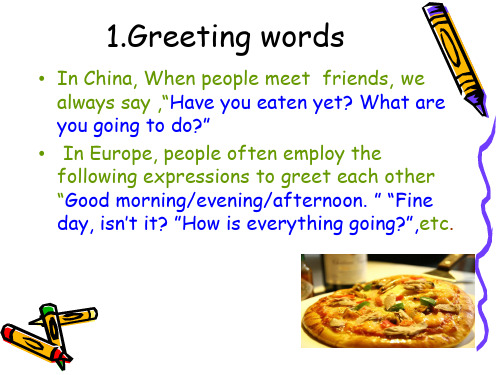
10.Invitation
Chinese:welcome uninvited guest
Foreigners:consult a time before you invite somebody
4.Differences in gift
Chinese:expensive
Foreigners:easy and cheap
5.Differences when
receiving gift
Chinese:Don’t open the gift
Foreigners:open the gift
6.The form of addressing
“Thank you” is widely used in English to show gratitude in such cases as being invited, helped, given a gift, etc.
9. Asking Personal Affairs
People from China do not regard it as asking personal affairs when they ask others name、age、marital status、 wages、personal life、belief and political points. It is regard as concerns.
In China, use "title
+surname" to address their superior or elders.
中西服饰文化差异
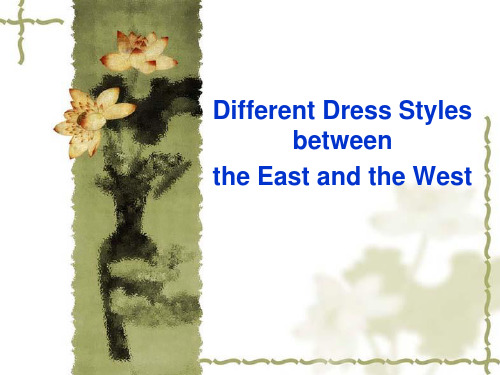
中西方服饰差异
In Western clothes cultural differences
一、色彩比较
中式服装色彩 偏重黄色红色; 西式服装色彩 偏重白色紫色
在上古时代,黑色被中国的先 人认为是支配万物的天帝色彩。 夏、商、周时天子的冕服为黑 色。后来随着封建集权专制的 发展,人们把对天神(黑色) 的崇拜转向对大地(黄色)的 崇拜,所以形成“黄为贵”的 传统观念。传统服装色彩受阴 阳五行影响,有青、红、黑、 白、黄五色之说。它们被称为 正色,其它颜色为间色,正色 在大多数朝代为上等社会专用, 表示高贵。
孙中山
Sun Yat-sen
中山装
中山装是以孙 文的名字命名 的一种服装。。 由于中国著名 政治人物毛泽 东经常穿着中 山装示人,所 以西方人称呼 中山装为“毛 装”(Mao Suit),
Chinese tunic suit
tunic suit)是在广 泛吸收欧美服饰的基础上,近现代中国 国父孙中山先生综合 孙中山了西式服装 与中式服装的特点,设计出的一种直翻 领有袋盖的四贴袋服装,并被世人称为 中山装,此后中山装大为流行,一度成 为中国男子最喜欢的标准服装之一。
西欧服装上的图案随 着历史的变迁而不断 变化。古代多流行花 草放样,意大利文艺 复兴时期流行华丽的 花卉图案,法国路易 十五时期,受洛可可 装饰风格的影响,流 行表现S形或旋涡形 的藤草和轻淡柔和的 庭院花草花样。
三.材料工艺的比较
1. 中式服装材料以丝绸 为主; 西方服装材料以毛呢 为主
2.中式服装裁制时注意工
在西方,最流行的色 彩是白色和紫色,白 色代表纯洁、正直, 紫色象征高贵。中世 纪时奇特式教堂中彩 色玻璃窗被装饰得辉 煌灿烂,引导人们追 求天堂的色彩,因此 服饰上充满宗教气氛 的色彩被人们向往。 欧洲文艺复兴以来, 随着服饰奢华程度的 升级,明亮的色彩受 到人们的欢迎。
中西方服装文化差异英语作文

中西方服装文化差异英语作文英文回答:Cultural disparities between Eastern and Western attire are multifaceted and reflect the distinct historical, social, and aesthetic values of each civilization.Eastern attire, often associated with modesty and collectivism, emphasizes comfort, functionality, and symbolism. Traditional garments like the kimono in Japan, the cheongsam in China, and the hanbok in Korea prioritize loose-fitting silhouettes, breathable fabrics, andintricate patterns that convey cultural identity and social status.In contrast, Western attire has historically favored individualism, opulence, and ornamentation. Clothingdesigns from the Renaissance to the present have showcased elaborate cuts, vibrant colors, and detailed embellishments. Tailored suits, gowns, and dresses emphasize the wearer'sbody shape and personal style, reflecting a preoccupation with appearances and self-expression.Other notable differences include:Material: Eastern garments often incorporate natural fibers like cotton, silk, and linen, while Western attire may feature a wider range of materials, including synthetics and animal products.Color: Eastern attire tends towards muted tones and monochromatic palettes, while Western attire embraces a broader spectrum of colors, from vibrant hues to neutrals.Formality: Eastern attire often distinguishes between formal and informal occasions, while Western attire has a more fluid approach to formality, with many garments serving both casual and dressy purposes.Influences: Eastern attire has been influenced by Buddhism, Taoism, and Confucianism, while Western attire has been shaped by Christianity, the Enlightenment, andindustrialization.中文回答:东西方服饰文化差异丰富多样,反映了不同文明独特的历史、社会和审美价值观。
中西方服装文化差异英文汇总

Chinese Tunic Suit 中山装
Chinese Tunic Suit, also called “Zhongshan Zhuang” in Chinese, is a kind of traditional male attire.
Modern clothes in China
Chinese wear pattern structure is mainly straight, few arcs and curve.
China: conservative VS the West: opening
Major Traditional Chinese clothes
Chinese Cheongsam旗袍
The cheongsam is a female dress with distinctive Chinese features and enjoys a growing popularity in the international world of high fashion.
Wide, easygoing, elegant is the basic elements of traditional Chinese costume.
In Chinese clothing culture, there some traditional and important color like red.
The Western Palace clothes are produced complicatedly, symbolizing their noble status.
Western-style clothes is dynamic, clipping apparel sculpt seeking a bulk feeling and dynamic law feeling.
中西方服装文化差异英文ppt
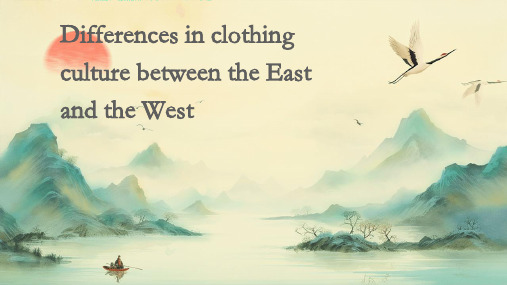
Chinese clothing styles are diverse, emphasizing the integration of traditional and modern elements. Traditional styles such as qipao and Hanfu have been improved to better conform to modern aesthetics. Western clothing, on the other hand, places more emphasis on fashion and personalization, constantly innovating and leading the trend.
01
The Origin and History of Chinese and
Western Clothing
The Origin and History of Chinese Clothing
• The Origin and History of Chinese Costume • Chinese clothing originated in ancient times and gradually formed a
Chinese clothing often uses natural fibers such as silk, linen, cotton, etc., emphasizing traditional handicrafts and the texture of natural materials. Western clothing, on the other hand, tends to use synthetic fibers and blended materials, emphasizing fashion and functionality.
中西服装差异英语作文

中西服装差异英语作文英文回答:In the realm of fashion, the garments that adorn our bodies serve as both a reflection of our cultural heritage and a means of personal expression. The world of attire encompasses a vast tapestry of styles, with each culture weaving its own unique aesthetic thread into the fabric of human expression. Among the most prominent cultural influences on fashion are the East and the West, each possessing its own distinct set of sartorial norms and traditions.Eastern garments, particularly those originating in China and Japan, are renowned for their flowing silhouettes, intricate designs, and vibrant colors. The kimono, a traditional Japanese robe, epitomizes the elegance andgrace of Eastern attire. Its loose, flowing shape allowsfor freedom of movement, while its intricate patterns and vibrant hues evoke a sense of artistry and refinement.Chinese garments, such as the qipao, also feature flowing lines and vibrant colors, often adorned with intricate embroidery or beadwork.Western garments, on the other hand, tend to emphasize structure and tailoring. The suit, a quintessential Western garment, exemplifies this sartorial approach. Its sharp lines, tailored fit, and muted colors convey a sense of authority and sophistication. Other Western garments, such as jeans and T-shirts, prioritize comfort and functionality, reflecting the pragmatic nature of Western culture.Beyond their aesthetic differences, Eastern and Western garments also reflect distinct cultural values and philosophies. Eastern attire often symbolizes harmony with nature and a connection to the spiritual realm. The kimono, for instance, is often worn during traditional tea ceremonies, where it serves as a reminder of the importance of mindfulness and tranquility. Western garments, in contrast, often embody the values of individualism andself-expression. The suit, for example, is associated with power and success, while jeans and T-shirts represent amore relaxed and casual approach to life.As the world becomes increasingly interconnected, cultural influences permeate borders, and fashion trends evolve in response to a tapestry of cultural exchanges. Eastern and Western garments have found their way into each other's wardrobes, creating a kaleidoscope of styles that defy traditional boundaries. Designers from both cultures have embraced elements from different sartorial traditions, resulting in a fusion of aesthetics that celebrates the beauty and diversity of human expression.中文回答:东西方服饰差异。
中西服装对比

说到中西方的差异,便不能不提两边服饰的差异。
若要说两方的代表性衣物,东方莫过于中山装(zhongshan suit)和旗袍(cheong sam),西方则是西服(western suit)和中世纪华丽的裙子(dress)。
但中西服饰文化差异并非外形这么简单,一个民族的服饰特点渗透着一个民族深厚的文化底蕴。
以中山装和西装、旗袍和西式裙子为例,都能反映出两方在文化上的差异。
中山装(Zhongshan suit)近现代中国国父孙中山先生综合了西式服装与中式服装的特点,设计出的一种直翻领有袋盖的四贴袋服装,并被世人称为中山装,此后中山装大为流行,一度成为中国男子最喜欢的标准服装之一。
中山装实用、方便,不像西装那样,除上衣、衬衣外,还要硬领。
中山装所代表的文化意义在于它的每一个设计都蕴含着孙中山先生的政治思想。
四个口袋代表礼、义、廉、耻;胸前的五粒纽扣和五个口袋分别表示五权宪法学说;左右袖口的三个纽扣则分别表示三民主义和共和的理念;衣领表示严谨的治国理念;背部不缝缝,表示国家和平统一之大义。
不过随着时代的进步,西服相比于中山装更加流行和普及。
西装的主要特点是外观挺括、线条流畅、穿着舒适。
若配上领带或领结后,则更显得高雅典朴,给人一种有绅士风度的感觉。
相比于中山装,西服款式变化多端,风格多变,不同款式的西服能使穿着之人给人以不同的感觉。
并且随着时代的进步西服已从男士西服普及到男女皆能穿,增加了人们在穿着上的选择空间。
西服与中山装的主要不同在于,第一西服有垫肩,中上装没有垫肩;第二中山装胸前扣子要扣到领口,而西服往往只有1-3颗扣子并且可以不用扣。
再来谈谈女性服装的差异,东方以旗袍为例,旗袍是改良自清代满族女子的旗装,是一种贴身高领下摆高开叉的连体裙子。
旗袍轻便简约贴身,能凸显出女子的的曲线和窈窕美感。
旗袍让人显得修长,是对东方人较为矮小的身材之弥补。
此外旗袍虽然变化多端,但整体确是万变不离其宗。
旗袍的产生显示出随着时代进步女子思想的开放和对于美的追求。
中西文化差异英文简短

中西文化差异英文简短中西文化差异是一个复杂而广泛的话题,以下是一些简短的英文描述:1.Value Systems(价值体系): Western culture emphasizes individualism, independence, and personal achievements, while Chinese culture highlights collectivism, interdependence, and harmony within the group.2.Communication Styles(交流方式): Direct and assertive communication is preferred in Western cultures, whereas indirect and polite communication is valued in Chinese culture to maintain social harmony.3.Time Orientation(时间观念): Western cultures tend to be future-oriented, emphasizing planning and scheduling, while Chinese culture is more present-oriented, focusing on the importance of the moment and relationships.4.Social Etiquette(社交礼仪): In Western cultures, people often maintain a personal distance and privacy, while inChinese culture, there is a greater emphasis on social connections, networking, and saving face.5.Perception of Authority(权威观念): Western cultures generally have a more democratic approach and value challenging authority, whereas Chinese culture places a high degree of respect for elders, hierarchy, and tradition.请注意,这些只是一些一般性观察,并不能涵盖所有个体情况。
中西方文化差异英语作文
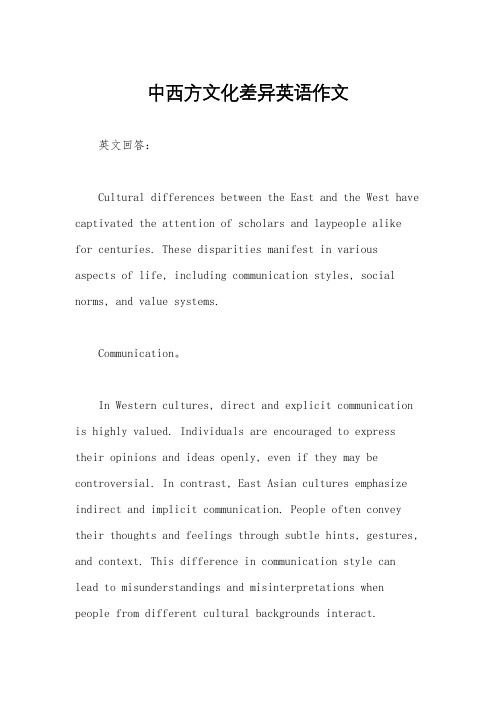
中西方文化差异英语作文英文回答:Cultural differences between the East and the West have captivated the attention of scholars and laypeople alikefor centuries. These disparities manifest in various aspects of life, including communication styles, social norms, and value systems.Communication。
In Western cultures, direct and explicit communication is highly valued. Individuals are encouraged to express their opinions and ideas openly, even if they may be controversial. In contrast, East Asian cultures emphasize indirect and implicit communication. People often convey their thoughts and feelings through subtle hints, gestures, and context. This difference in communication style can lead to misunderstandings and misinterpretations when people from different cultural backgrounds interact.Social Norms。
Social norms play a crucial role in shaping behavior in both East and West. In Western cultures, individualism is prevalent. People are encouraged to pursue their own goals and desires, even if they conflict with the norms of their society. In contrast, East Asian cultures place a greater emphasis on collectivism. Individuals are expected to prioritize the needs of their group or family over their own. This difference in social norms can lead to different behaviors and expectations in various social situations.Value Systems。
- 1、下载文档前请自行甄别文档内容的完整性,平台不提供额外的编辑、内容补充、找答案等附加服务。
- 2、"仅部分预览"的文档,不可在线预览部分如存在完整性等问题,可反馈申请退款(可完整预览的文档不适用该条件!)。
- 3、如文档侵犯您的权益,请联系客服反馈,我们会尽快为您处理(人工客服工作时间:9:00-18:30)。
魏晋
南 北
隋唐时期
During the Sui and Tang Dynasties
The Tang dynasty women, is China clothing in the history of the most wonderful
chapter, is the ancient leader. Women's dress is one of the most ancient China bold, its shape is elegant, stately robes. Clothing with sleeves, to show it, stretch, give a person with a sense of floating in the air if the fairy. Jacket shirt, wide
古罗马
男子:Toga and Chunica man the main clothing. These two kinds of clothes for wool fabric, the overall appearance is more thick, the air is terrible.
女子:Women's clothing mainly Situola, para. These two kinds of clothing for the coat, but at this time also appeared in women's underwear, briefs the chest strap and the Romans, costumes reflect the practical thought of clothing.
胸衣由后面系戴, 下部呈尖三角形, 鲸须竖直嵌入, 尺寸贴身,比较 舒适
02 中国服装发展 The development of China Costume
商周时期
Fabric color in this period, with warm color more, especially with Huang Hong, with brown and brown, but this does not mean that there is no basket, green and other colors.
文艺复兴时期服装
Renaissance Costume
A burly man dress upper body and lower on the lean, a box shape. Women's clothing on a low waist to hip ratio, forming the shape of flip bell, also appeared a topless low cut, and no longer shy covered with decorative fabri.
男装最大的特点就是大袖子花边 了,带马刺的靴子也成了时髦, 还有羽毛大帽子和佩剑。
女装:Coat some lace collar neck, some up to the chest. The sleeves are characteristic, a section ofthe hoop, a layer of decorative lace.
sleeves, dress, is the Tang Dynasty phenomenon.
隋
唐
宋
宋元时期
During the song and Yuan Dynasties dress with slender beauty, compared with women
in the Tang Dynasty, was significantly reversed by
Women's clothes are generally robes, also called cheongsam, body length, length to
the ground to cover its shoes. Robes outside more, also called Waistcoat Vest.
清
明朝
大清
妇女的便服一般为长袍,也叫旗 袍,通体长,长至地面掩住旗鞋。 长袍外面多加马甲,也叫坎肩。
民国时期
The period of the Republic of China
旗袍 Cheongsam
Cheongsam is closely related to the high collar, give a person with elegant and solemn feeling, micro tight waist reflect the waist hip curve; especially on both sides of the slits, walking the angle of micro light waves, with a lively sense of.
中世纪时期服 装
Medieval Costume Bourriau is a big trumpet sleeves, neckline dress to the cylinder, a triangle, a luxury decorative edge, a ribbon at the腰围线 开始斜向后下方,是下一时代燕尾服的 先声,现代晨礼服的始祖。
女: Her from behind the wear, the lower part is triangular, vertical embedding dimension baleen, close fitting, comfortable.
dress coat, short skirt length becomes long skirt jacket with short features, in the skirt piece below one or two inch position lace.
元
明清时期
明
During the Ming and Qing Dynasties
The characteristics of the clothing is facing backward from the start below the waistline, announced the next time a tuxedo, ancestor of the modern morning coat.
秦汉时期
秦
Dress culture in Qin and Han Dynasties on women's dress is simple, clothes, shoes and men without much of a difference, no towels, belt and other accessories on the body, the head is in a simple bun, without any decoration. The men's clothing in the robe, so expensive, woman with dark clothing is.
女性头饰
洛可可时期服饰
Rococo Costume
There is a large amount of box fold fold in the back of neck, shoulder and from the ground, elegant and smooth. Because the court painter Watteau chose this dress model as the object the painting, they are called the head rob.
拜 占 庭 时 期
布 里 奥
中世纪哥特时期服装
The medieval Gothic period Costume
Kotal Di's fourteenth Century appearance, originated in Italy, from the waist to hip is very fit, in the central or armpit with fixed the button or the rope, the collar was bare shoulders, hips down into many triangular cloth, long sleeve off, tight half sleeve.
Before the Middle Ages in ancient costume
希玛顿 CIMA.
01 西方服装发展
The developmen
This is a Greek men and women wear long coat covered. It has no fixed shape, there are two kinds of thin and crisp. In many ways, divided body wrap, shoulder, shoulder, shoulder armor type.
03 04
Modern fashion elements
Part of the national costume
Dress culture is a cultural phenomenon unique to human beings. As it has different aesthetic ideas, different dressing concepts and different dress etiquette in China and west, it forms Chinese and western dress culture of the different connotation and characters
